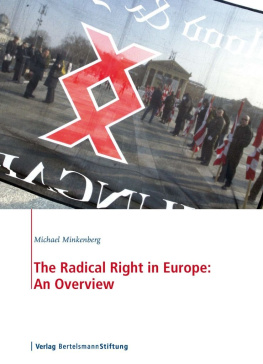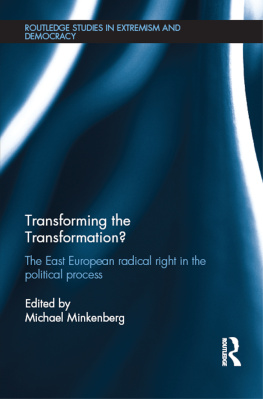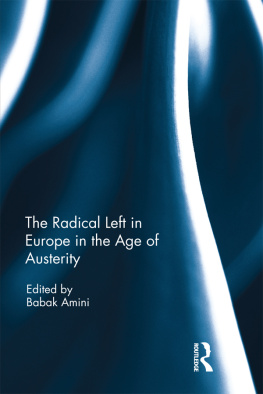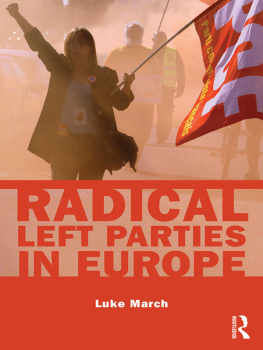Bibliographic information published by the Deutsche Nationalbibliothek
The Deutsche Nationalbibliothek lists this publication in the
Deutsche Nationalbibliografie; detailed bibliographic data
is available on the Internet at http://dnb.d-nb.de.
2011 E-Book-Ausgabe (EPUB)
Responsible: Dr. Orkan Ksemen
Production editor: Christiane Raffel
Cover design: Nadine Humann
Cover illustration: AFP/Getty Images, Attila Kisbenedek
Typesetting: Katrin Berkenkamp, Designwerkstatt 12, Bielefeld
ISBN : 978-3-86793-066-6
www.bertelsmann-stiftung.org/publications
www.bertelsmann-stiftung.de/verlag
Inhaltsverzeichnis
Preface
European challenges call for European responses. The spread of extremist and xenophobic attitudes and the proliferation of right-wing political movements are challenges confronting all of Europe. These countries can learn from each other as they seek ways of dealing with such extremism. This applies particularly to Germany, where the public debate has paid far too little attention to the successful strategies and experiences of other countries. As Europe becomes more unified, sharing knowledge about existing strategies for combating right-wing radicalism and attitudes in the neighboring countries becomes increasingly important for every European country.
The Bertelsmann Stiftung is contributing to this European debate. It has commissioned Professor Michael Minkenberg, who is one of the leading experts in this field, to write a comparative report. The report provides a conceptual framework for comparing right-wing radicalism in Europe and includes country specific data on the right-wing radicalism and extremism. His report constitutes a solid base of knowledge on the current situation in ten European countries. It gives us an overview of right-wing radical political party successes, the strength of their movements, the existence of sub-cultural milieus of the radical right and of corresponding factors that influence the rise of the radical right in Europe.
The selected countries in this report vary in terms of democratic systems and immigration policies. Austria, Germany and Switzerland are consensus democracies (which means there are many political and institutional checks and balances) that have restrictive immigration policies. Belgium and the Netherlands are in the same category of consensus democracies but the former pursues a moderate immigration policy whereas the latter has until recently implemented an open immigration policy when it comes to immigration control. In contrast, the study examines Great Britain and France with majoritarian systems with little checks and balances. But the two countries differ in their immigration policies-Great Britains is considered to be moderate, the one in France is open. Denmark, Italy and Sweden have mixed democratic systems: the executive is restricted by a certain degree by political or institutional factors. Nevertheless, all three employ different immigration policies. Denmark is restrictive, Italy moderate and Sweden is open. Altogether this selection provides us with diverse country cases where the regulation of the immigration flow varies and the number of political actors that influence decisions is different. Both factors do have an impact on how right-wing extremism is addressed by mainstream politics and society.
This report will be followed by further research. The focus will on how the selected countries are combating right-wing radicalism at the national level. The main interest of the Bertelsmann Stiftung is: to push forward a European exchange about successful strategies against right-wing extremism and to help Germany learn from its neighbors in a field vital to the stability of democracy. We are much obliged for Professor Minkenbergs contribution to this goal.
Ulrich Kober
Orkan Ksemen
1 Introduction
The purpose of this report is not to provide a novel piece of research for an academic or wider audience but to offer country-specific data and a few conceptual thoughts and contextual comparative data on the radical right in Europe, which are needed in order to arrive at ideas of how to manage analytically and confront politically its various manifestations. What are the central dimensions of the challenge at hand?
1. The contemporary radical right is a modern phenomenon. It has undergone a phase of renewal as a result of social and cultural modernization shifts in post-war Europe, or has emerged as a truly new phenomenon in the course of regime change in Central and Eastern Europe after 1989. Thus todays radical right is only vaguely connected with previous versions. Terms like fascism or neo-fascism, which suggest a historical continuity from Munich to Mlln, Magdeburg and Marzahn in Germany, or from Vichy to Vitrolles in France, become increasingly obsolete.
2. The contemporary radical right is an international phenomenon. Thus, more than before, comparative approaches are needed both to analyze the cross-national aspects and to specify the nation-specific characteristics. Still, even in some comparative work, definitions of the radical right prevail which derive their criteria from the respective national traditions. More than ever before, the study of the radical right, even in a particular country, should consider international contexts in which the radical right operates.
3. The contemporary radical right is a complex phenomenon. Twenty years ago, Klaus von Beyme advised: Future studies of right-wing extremism will have to pay more attention to the whole political context of this political movement instead of being preoccupied with traditional party and electoral studies (von Beyme 1988: 16). This is still valid, at least in the field of the comparative study of the radical right which requires combining party research with other strands of research (movement research, youth sociology) in order to do justice to the complex nature of the radical right and the ensuing challenge (for recent reviews of the party literature on the radical right, see Carter 2005, Kitschelt 2007 and Mudde 2007).
4. The radical rights renewal, internationality, and multidimensionality should also inform the question of how to deal with the radical right. Often, a focus on particular aspects (such as party strategies or a criminalization of the radical right) dominates the debates, or national viewpoints prevail, such as the German tendency to judicialize political issues and to follow the logic of constitutional and legal concepts, as in the German Verfassungsschutz.
The following report on ten selected European democracies (Austria, Belgium, Denmark, France, Great Britain, Hungary, Italy, the Netherlands, Sweden and Switzerland) highlights the characteristics of the radical right in these countries and provide contextual information regarding their demographic characteristics and sociopolitical environment. The selection of these countries was primarily guided by the criteria of variation in the radical rights political success and organization (i.e., variation in electorate support, in strength of parties, in movement-type mobilization) and variation in the countries contextual characteristics. The list of countries is by no means exhaustive and it does not include other relevant cases such as Norway, Spain or Poland. Also, the report does not attempt to analyze the reasons behind the radical rights success or failure in these countries. It is organized in four sections: first, an overview of the major demographic facts and trends; second, a discussion of the political performance of the radical right; third, a characterization of the sociopolitical environment of the radical right; and fourth, a few words on the state of data collection in each country.











